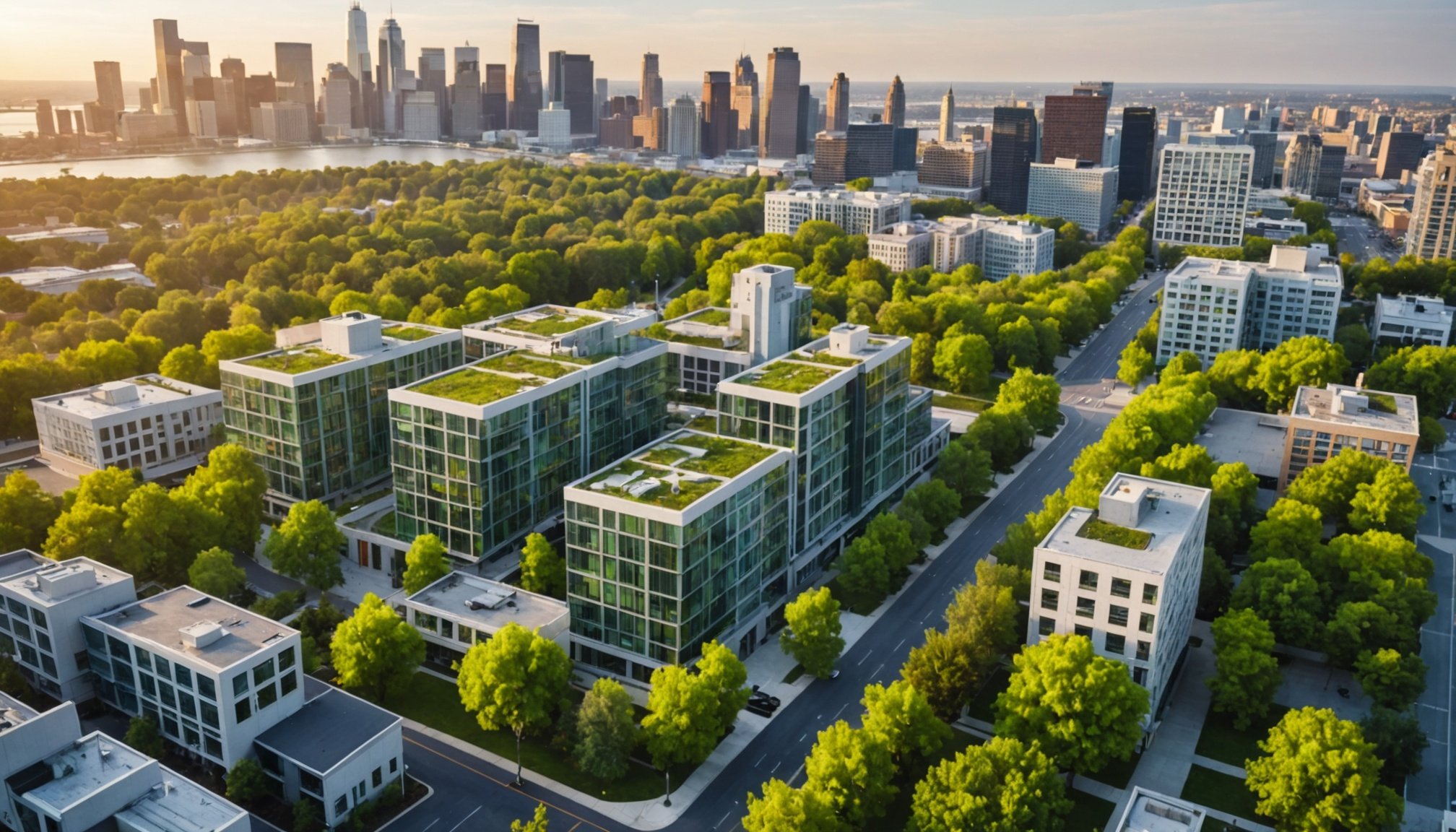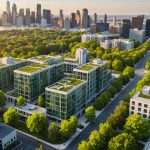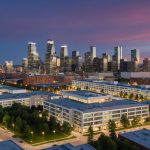Unlock Urban Savings: Explore the Financial Perks of Green Building Standards in City Planning
As cities continue to grow and urbanization accelerates, the need for sustainable and environmentally friendly urban planning has become more pressing than ever. One of the most effective ways to achieve this is through the adoption of green building standards. Not only do these standards help in reducing the environmental footprint of cities, but they also offer a plethora of financial benefits that can be a game-changer for urban development.
Understanding Green Building Standards
Green building standards refer to practices and constructions that minimize environmental impact while offering social and economic benefits. These standards include the use of eco-friendly materials, energy efficiency, and design aimed at preserving natural resources.
Also to see : Unlock Higher Returns: Discover the Financial Benefits of Energy-Efficient Commercial Real Estate Investments
Key Components of Green Buildings
- Energy Efficiency: Green buildings are designed to minimize energy consumption through advanced insulation, high-performance windows, and intelligent management systems. For instance, a friend who renovated his apartment by installing solar panels and a low-consumption heating system managed to reduce his energy bill by 60%[1].
- Water Management: Efficient water use is another critical aspect. Systems for collecting and reusing rainwater, as well as water-saving devices, are common features. A visit to an energy-positive building revealed a sophisticated water management system that reduced water consumption by 50%[1].
- Green Roofs and Infrastructure: Green roofs and green infrastructure are integral to green buildings. These not only provide insulation but also create habitats for local biodiversity and help in managing stormwater runoff.
Financial Benefits of Green Buildings
Investing in green buildings is not just a moral imperative; it also makes sound financial sense.
Reduced Operational Costs
Green buildings are often more energy-efficient, leading to lower operational costs. For example, an investor who installed ecological solutions in a building complex saw a 40% reduction in energy costs, significantly boosting his profitability[1].
Also to read : Unlock Higher Returns: Discover the Financial Benefits of Energy-Efficient Commercial Real Estate Investments
Increased Property Value
The trend towards sustainability can lead to a faster appreciation of green buildings. Studies have shown that green buildings tend to sell better due to the increasing demand for environmentally respectful properties. This trend is something many investors have observed in their portfolios, with some properties retaining or even increasing their value during market fluctuations[1].
Attraction of Tenants
With a growing demand for ecological housing, investors can benefit from higher occupancy rates and increased rents. A conversation with a sustainable building owner revealed a significant influx of tenants interested in greener living options, thereby increasing his rental income[1].
Government Incentives and Climate Finance
Governments around the world are offering various incentives to encourage the development of green buildings.
Tax Incentives and Subsidies
Many governments provide tax reductions, credits, or subsidies for environmentally respectful projects. These measures can significantly improve the profitability of green building investments. For instance, several investors have benefited from these programs to offset the initial costs of their projects[1].
Climate Finance Initiatives
Climate finance initiatives are becoming more prevalent, providing funding for projects that aim to reduce carbon emissions. Local governments and private sector entities are collaborating to fund green infrastructure projects, making it more feasible for building owners to adopt sustainable practices.
| Incentive Type | Description | Example |
|---|---|---|
| Tax Credits | Reduction in taxes for green building projects | U.S. federal tax credits for solar and wind energy installations |
| Subsidies | Financial grants for sustainable development | European Union subsidies for green infrastructure projects |
| Climate Finance | Funding for projects aimed at reducing carbon emissions | Green Climate Fund supporting urban green infrastructure in developing cities |
| Low-Interest Loans | Special loan programs with lower interest rates for green projects | Local government loans for energy-efficient building renovations |
Public-Private Partnerships in Green Development
Public-private partnerships are crucial in driving the adoption of green building standards.
Collaborative Urban Planning
Local governments and private sector entities are working together to develop sustainable urban infrastructure. For example, in some cities, public-private partnerships have led to the development of green spaces, green roofs, and energy-efficient buildings. These collaborations not only enhance the urban climate but also provide economic benefits through reduced maintenance costs and increased property values[1].
Community Engagement
Engaging the local community is essential for the success of green building projects. Projects that include public spaces for leisure, community gardens, or programs to help low-income families find housing not only attract tenants but also have a positive impact on the investor’s reputation. A local campaign in my city to educate future buyers about the importance of green buildings led to an increase in sales of ecological properties[1].
Integrating ESG Criteria into Investment Strategies
Integrating Environmental, Social, and Governance (ESG) criteria into investment strategies is becoming increasingly important.
Environmental Analysis
Evaluating the environmental impact of building projects before investing is crucial. This can include construction impact studies, energy audits, or examining waste management practices. For instance, using tools like the Diagnostic of Energy Performance (DPE) can provide a clear idea of a building’s energy consumption[1].
Social Engagement
The social aspect of ESG criteria involves considering projects that improve the quality of life in the communities where they are located. A residential building project that includes public leisure spaces or housing assistance programs for low-income families can attract tenants and have a positive impact on the investor’s reputation[1].
Governance and Transparency
Evaluating the governance of a company or project is equally critical. A company with transparent practices and good governance is less likely to face controversies, which can avoid investment losses. Investors should look for certifications like LEED or HQE, which evaluate environmental, social, and economic aspects and testify to the seriousness of the constructor[1].
Contribution to Climate Change Mitigation
Green buildings play a significant role in mitigating climate change.
Reducing Carbon Emissions
The construction and operation of buildings account for a significant portion of global greenhouse gas emissions, but green buildings aim to reverse this trend.
- Eco-Friendly Materials: Using sustainable materials like certified wood or recycled materials limits the carbon footprint of new constructions. Developers choosing local materials reduce transportation distances and associated emissions[1].
- Energy Efficiency: Green buildings are designed to minimize energy consumption through advanced insulation, high-performance windows, and intelligent management systems. For example, integrating solar panels and low-consumption heating systems can reduce energy bills significantly[1].
- Sustainable Transport: Green building projects often include infrastructure that promotes alternative transportation, such as bike paths, electric vehicle charging stations, or access to efficient public transport. This encourages residents to opt for less polluting modes of transport, reducing their overall carbon footprint[1].
Improving Urban Quality of Life
Beyond environmental benefits, green buildings significantly improve the quality of life for urban residents.
Green Spaces and Biodiversity
Green buildings often include green spaces such as community gardens, parks, and green roofs. These not only provide insulation but also foster biodiversity and help manage stormwater runoff. For instance, a project that included extensive green roofs and community gardens saw a significant increase in local wildlife and improved air quality[1].
Health and Well-being
Living in green buildings can have direct health benefits. Studies have shown that residents of green buildings experience improved air quality, reduced noise pollution, and better mental health due to the presence of natural environments. A friend who moved into a green building reported improved overall well-being and a reduction in respiratory issues[1].
Practical Advice for Investors
For those considering investing in green buildings, here are some practical tips:
Conduct Thorough Environmental Evaluations
Before investing, evaluate the environmental performance of the building. Use tools like the Diagnostic of Energy Performance (DPE) to get a clear picture of the building’s energy consumption.
Explore Government Incentives
Look into government incentives such as tax credits, subsidies, and climate finance initiatives that can offset the initial costs of green building projects.
Engage with Local Communities
Engage with local communities to understand their needs and preferences. Projects that include public spaces and community programs can attract more tenants and enhance the investor’s reputation.
Integrate ESG Criteria
Integrate ESG criteria into your investment strategy to ensure that your investments are not only financially sound but also socially responsible and environmentally sustainable.
Investing in green buildings is a forward-thinking strategy that offers numerous financial benefits while contributing to a more sustainable future. By understanding the components of green buildings, leveraging government incentives, and integrating ESG criteria, investors can navigate the complexities of this emerging market successfully. As cities continue to grow, adopting green building standards is not just a moral imperative but a financially savvy move that can lead to long-term savings and a healthier urban environment.
In the words of a seasoned investor, “Investing in green buildings is not just about doing good; it’s about doing well. The financial perks, combined with the positive impact on the environment and society, make it a compelling choice for any forward-thinking investor.” As we move towards creating more sustainable cities, embracing green building standards is a step in the right direction, offering a win-win scenario for both the environment and the investor’s bottom line.











